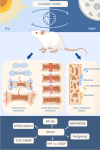Signaling pathway mechanisms of circadian clock gene Bmal1 regulating bone and cartilage metabolism: a review
- PMID: 39870641
- PMCID: PMC11772753
- DOI: 10.1038/s41413-025-00403-6
Signaling pathway mechanisms of circadian clock gene Bmal1 regulating bone and cartilage metabolism: a review
Abstract
Circadian rhythm is ubiquitous in nature. Circadian clock genes such as Bmal1 and Clock form a multi-level transcription-translation feedback network, and regulate a variety of physiological and pathological processes, including bone and cartilage metabolism. Deletion of the core clock gene Bmal1 leads to pathological bone alterations, while the phenotypes are not consistent. Studies have shown that multiple signaling pathways are involved in the process of Bmal1 regulating bone and cartilage metabolism, but the exact regulatory mechanisms remain unclear. This paper reviews the signaling pathways by which Bmal1 regulates bone/cartilage metabolism, the upstream regulatory factors that control Bmal1, and the current Bmal1 knockout mouse models for research. We hope to provide new insights for the prevention and treatment of bone/cartilage diseases related to circadian rhythms.
© 2025. The Author(s).
Conflict of interest statement
Competing interests: The authors declare no competing interests.
Figures


References
-
- Curtis, A. M., Bellet, M. M., Sassone-Corsi, P. & O’Neill, L. A. J. Circadian clock proteins and immunity. Immunity40, 178–186 (2014). - PubMed
-
- Pendergrast, L. A. et al. Metabolic plasticity and obesity-associated changes in diurnal postexercise metabolism in mice. Metabolism. 155, 155834 (2024). - PubMed
-
- Rogers, N. & Meng, Q.-J. Tick tock, the cartilage clock. Osteoarthr. Cartil.31, 1425–1436 (2023). - PubMed
Publication types
MeSH terms
Substances
Grants and funding
LinkOut - more resources
Full Text Sources

